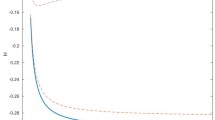Abstract
A Monte-Carlo study is presented for irreversible kinetic gelation in binary polymers in three dimensions. Using a growth scheme where attempts are made to form bonds with the help of radicals with probabilityk/(1+k) and without the help of radicals with probability 1/(1+k), wherek=0,1,2, ..., ∞, we have studied the crossover from one universality class of critical phenomena in kinetic gelation to another universality class of random percolation. In the radical assisted gelation, several features are incorporated to make the model more realistic, for example, the conservation of the number of radicals during the growth (more suited for living anionic polymerization), the introduction of poisons and chain-preferring reactions are considered. Conserving the radicals delays gelation as well as trapping. The trapping can also be delayed by increasing the functionality of the monomers. The effect of the poison is rather severe; even a small concentration of poison (c p >2%) terminates the reaction well before the gel point in a mixture of binary and ternary monomers, and it seems to affect the critical phenomena in the sol-gel phase transitions. In our growth mechanism, where reactions prefer to growL length steps each in a random direction, the critical phenomena remain unaffected by the length scale, but the flexibility of varying the chain stepL allows us to study the changeover between the phase transition in different gel structures.
Similar content being viewed by others
References
P. J. Flory,J. Am. Chem. Soc. 63:3083, 3091, 3096 (1941);Principles of Polymer Chemistry (Cornell University Press, Ithaca, New York, 1953).
W. H. Stockmayer,J. Chem. Phys. 11:45 (1943);12:125 (1944).
M. Gordon and S. B. Ross-Murphy,Pure Appl. Chem. 43:1 (1975); M. Gordon and J. A. Torkington,Ferroeleclrics 30:237 (1980);Pure Appl. Chem. 53:1461 (1981).
P. G. de Gennes,Scaling Concepts in Polymer Physics (Cornell University Press, Ithaca, New York, 1979).
D. Stauffer, A. Coniglio, and M. Adam,Adv. Polym. Sci. 44:103 (1982); see also P. G. de Gennes,J. Phys. Lett. (Paris) L37:1 (1976); D. Stauffer,J. Chem. Soc. Faraday Trans. II 72:1354(1976).
W. Burchard,Adv. Polym. Sci. 18:1 (1982).
M. E. Fisher and J. W. Essam,J. Math. Phys. 2:609 (1961).
H. L. Frisch and J. M. Hammersley,J. Industr. Appl. Math. 11:894 (1963).
T. C. Lubensky and J. Isaacson,Phys. Rev. Lett. 41:829 (1978).
P. Manneville and L. de Seze, inNumerical Methods in the Study of Critical Phenomena, I. Della Dora, J. Demongeot, and B. Lacolle, eds. (Springer Verlag, Berlin, 1981).
R. M. Ziff, E. M. Hendriks, and M. H. Ernst,Phys. Rev. Lett. 49:593 (1982).
H. J. Herrmann, D. P. Landau, and D. Stauffer,Phys. Rev. Lett. 49:412 (1982); H. J. Herrmann, D. Stauffer, and D. P. Landau,J. Phys. A: Math. Gen. 16:1221 (1983).
R. Bansil, H. J. Herrmann, and D. Stauffer, preprint (1983); to be published inJ. Polym. Sci.
N. Jan, T. Lookman, and D. Stauffer,J. Phys. A: Math. Gen. 16:L117 (1983); N. Jan, T. Tookman, and D. L. Hunter, preprint (1983).
W. Burchard, private communication; he brought to our attention a very good review by M. Swarez,Adv. Polym. Sci. 49:1 (1983).
A. Rushton, F. Family, and H. J. Herrmann, to be published inJ. Polym. Sci.
R. B. Pandey and D. Stauffer,Phys. Lett. A 95:511 (1983).
W. Schmidt and W. Burchard,Macromolecules 14:370 (1981).
T. Tanaka,Sci. Am. 124 (January 1981).
J. Kertesz, B. K. Chakrabarti, and J. A. M. S. Duarte,J. Phys. A Gen. Math. 15:L13 (1982).
Author information
Authors and Affiliations
Rights and permissions
About this article
Cite this article
Pandey, R.B. Computer simulation of irreversible kinetic gelation: Crossover between random and kinetic growth, radical conservation, poisons, and chain-preferred reactions. J Stat Phys 34, 163–190 (1984). https://doi.org/10.1007/BF01770353
Received:
Issue Date:
DOI: https://doi.org/10.1007/BF01770353




